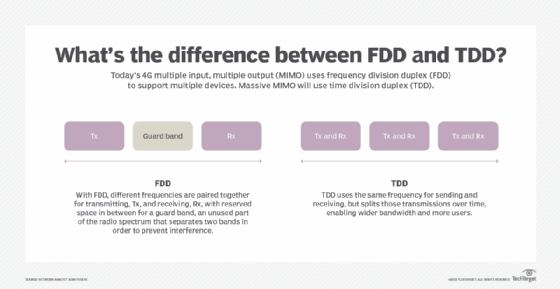What is 5G massive MIMO and how can it boost bandwidth?
With a large array of small antennas and time division duplex communication, 5G massive MIMO is expected to support more bandwidth and users with lower latency.
Mobile communication depends on antennas for transmission and reception. Originally, systems used a single antenna on each end, but they eventually migrated to multiple antennas for better support.
In today's Wi-Fi and 3G and 4G cellular technology, multiple input, multiple output (MIMO) arranges these antennas to boost transmissions. With 5G cellular, a new massive MIMO will boost bandwidth to users and support more users per antenna by incorporating a larger array of smaller antennas.
Today's 4G MIMO uses frequency division duplex (FDD) to support multiple devices, while 5G massive MIMO will use a different scheme, time division duplex (TDD).
With FDD, different frequencies are paired together for sending and receiving with reserved space in between for a guard band, an unused part of the radio spectrum that separates two bands in order to prevent interference. TDD uses the same frequency for sending and receiving, but splits those transmissions over time, enabling wider bandwidth and more users.
As expected from the word multiple in the acronym, MIMO relies on multiple antennas in both the base station and the mobile users in order to maximize performance. These antenna arrays are multiplied even further with massive MIMO as a much larger number of smaller antennas is used to help drive better client support.

The resulting benefit of 5G massive MIMO is greater bandwidth and more users in the same physical area. But, because of the smaller transmit wavelengths, the 5G signal will not travel as far, requiring more antennas to cover the same physical geography.
As 5G moves to production for carriers, expect to see far more antennas deployed. But don't worry, these smaller antennas will be less obtrusive than the current 4G antennas.

The net result of this new 5G massive MIMO technology will be greater bandwidth and lower latency while supporting higher user loads. Also, expect lower power consumption on mobile devices because of better antenna coverage.








